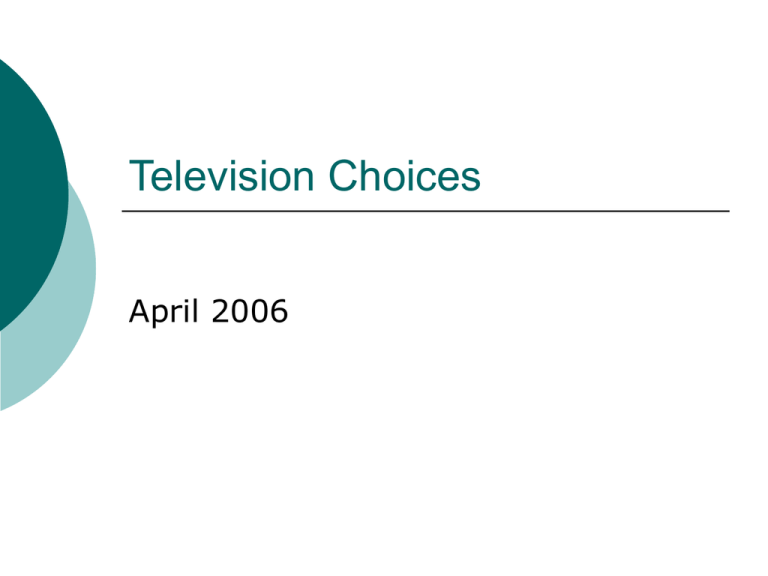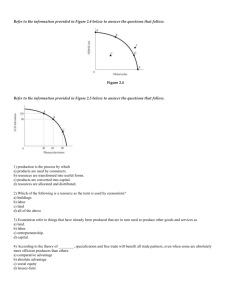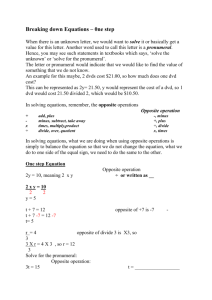Television Choices
advertisement

Television Choices April 2006 Types of TVs Flat Panel Projection- front and rear Plasma LCD DLP LCD LCoS Tube Flat Panel create bright, crisp images without using traditional picture tubes. super-slim, wall-mountable TVs use either plasma or LCD (Liquid Crystal Display) panels. Size: Up to 46" for LCD; up to 61" for plasma. Plasma Pros: screen's phosphor coating creates lifelike color that is closest to conventional tube TVs Cons: vulnerable to burn-in although it's less of an issue for newer models Size: 37"-61" LCD Pros: panels weigh less than plasma and use less energy; burnin not an issue Cons: picture slightly less natural than top plasmas Size: 13"-46" Projection- Rear (RPTV) clear, sharp pictures that look best when viewed straight on, from a seated position, looks dimmer if you're viewing from the side, or standing up. take up more space than direct-view TVs, and their larger screens require greater viewing distance for optimum results. Size: 42" to 70". Technology: DLP, LCD, or LCoS technology TVs have cabinets that are shallow and lightweight compared to conventional big-screen models RPTV Front-projection two-piece system: projector and screen. heavy, expensive CRT-based units that require professional installation and maintenance. compact, lightweight digital home theater projectors. big, bright images create more emotional impact than any other display type. Size: 40" to 300". Technology: DLP, LCD, and LCoS projectors. perform best in reduced light or darkness, Front Projection TV DLP (Digital Light Processing) developed by Texas Instruments, based on their Digital Micromirror Device (DMD) microchip. Each DMD chip has hundreds of thousands of tiny swiveling mirrors which are used to create the image. DLP technology is used in both front- and rear-projection systems. LCoS (Liquid Crystal on Silicon) sandwiches a layer of liquid crystal between a cover glass and a highly reflective, mirror-like surface patterned with pixels that sits on top of a silicon chip. layers form a microdisplay that can be used in rear-projection and front-projection TVs. Manufacturers use different names for their LCoSbased technologies. JVC uses D-ILA™ or HDILA™, while Sony uses SXRD™. Tube (direct-view CRT) (cathode-ray tube) TVs are what most of us watch. sharp, bright images provide a vivid viewing experience in virtually all rooms and lighting conditions. Size: Up to 36". Technology: Built around a single large CRT ("picture tube") — a specialized vacuum tube in which images are created when an electron beam scans back and forth across the back side of a phosphorcoated screen. Conventional TV Screen resolution number of horizontal pixels times the number of vertical pixels SDTV- 640 x 480 pixels HDTV- 1280 x 720 or 1920 x 1080 for EDTV (Enhanced-Definition)—852 x 480 Resolution HDTV - film-quality picture offers detail, dimensionality, and rich, vibrant colors that the 60-year-old analog NTSC TV format can't begin to match, include upconversion circuitry to give non-HD signals (DVD, antenna/cable, digital satellite, etc.) a cleaner, smoother look. SDTV digital format has better picture quality than existing broadcast and cable service. Aspect ratio — 4:3 vs. 16:9 conventional squarish 4:3 aspect-ratio - widescreen (most HDTV) 16:9 aspect ratio. 4:3 HDTV-ready TVs are required to include a special viewing mode that displays widescreen material like HDTV broadcasts and anamorphic DVDs in a 16:9 "window" with black bars above and below the picture. analog TV broadcasts are scheduled to end in 2009, and video programs will continue to shift to widescreen formats. 16:9 TVs can display 4:3 programs in a central 4:3 window with black or gray bars filling out the screen's width on the sides, also usually include several viewing modes designed to make 4:3 material fill the screen's width by magnifying and/or stretching the image. TV sound TV part of a home theater, use A/V receiver and speakers to process and deliver video sound built-in amplifier power output varies from 2 to 20 watts per channel. Higher power = cleaner, more realistic sound, and louder levels without distortion. RPTVs have more room in their cabinets for speakers ( usually 15+ watts per channel), sound quality good, still doesn't compare to even a budget-priced receiver and speakers. HDTV sets (those with some type of built-in HD tuner) include a digital output, through which they can send a crystal-clear Dolby Digital sound that is standard on HDTV broadcasts via a single-cable digital connection to your A/V receiver. Connections Video input type Connection Commonly used for coaxial (RF) threaded Ftype – carries audio and video signal antenna, cable TV, VCR composite video single RCA – carries video signal VHS VCR, DBS, DVD, VHS and 8mm camcorders, video game S-video 4-pin DINtypecarries video signal Super VHS VCR, DVD, MiniDV and Hi8 camcorders Connections Video input type Connection Commonly used for component video RCA x 3 – splits DVD, HDTV tuner (broadcast, cable or satellite) DVI multi-pin HDTV tuner, computer, DVD HDMI multi-pin HDTV tuner, DVD, HD DVR, HD DVD/Blu-ray Hook-ups TV built in A/V inputs- usually limited in number and types Hook-ups A/V home theater receivers provide multiple video inputs and outputs to enable video switching, which makes it easy to choose from among your various video sources. Hook-ups External switching devices/ RF converters Components Antenna, satellite TV receiver or cable box DVD player and VCR video game system(s) DVR/TiVo hard disk recorder camcorder-preferably front-panel A/V inputs



